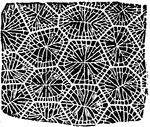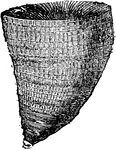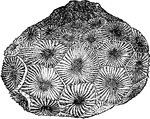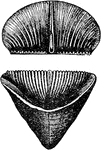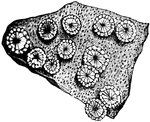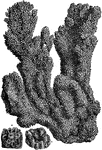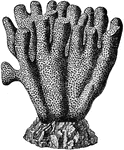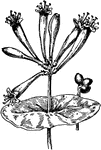
Trumpet Honeysuckle
Of the Honeysuckle family (Caprifoliaceae), the trumpet honeysuckle (Lonicera sempervirens).

Atoll
"Atoll, a coral reef surrounding a pool of shallow water, usually called a lagoon. The atoll is formed…
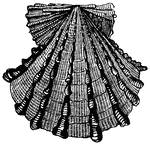
Pecten Foliaceus.
Smooth-shelled Pectens have colors that are frequently lively and brilliant. This is the Coral Pecten.

Caryophyllia Cyathus (Lamarck)
"This genus has the summit hollowed out into a starlike cup. It inhabits the Mediterranean, and is common…
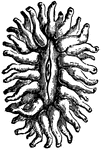
Flabellum Pavonium (Lesson)
"In the subfamily of the Zoanthidae, the polyps occur in clusters, and are multiplied by buds, rising…
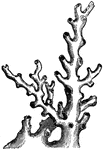
Oculina Virginea (Lamarck)
Oculina ranges from Cape Hatteras, North Carolina through the Gulf of Mexico and Caribbean, though the…
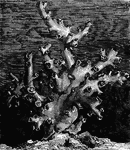
Dendrophyllia Ramea (De Blainville)
"The Madrepores abound in all inter-tropical seas, taking a considerable part in the formation of the…
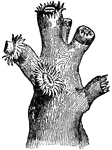
Dendrophyllia Ramea with Polypi (De Blainville)
"The Madrepores abound in all inter-tropical seas, taking a considerable part in the formation of the…
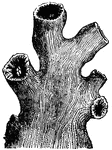
Dendrophyllia Ramea, Magnified (De Blainville)
"The Madrepores abound in all inter-tropical seas, taking a considerable part in the formation of the…
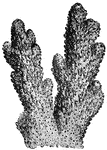
Madrepora Plantaginea (Lamarck)
"The Plantain Madrepore is an interesting species, the polyps presenting themselves in tufts, with slender…
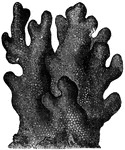
Porites Furcata (Lamarck)
"The polyp of the Porites is an animal somewhat pitcher-shaped, with twelve short tentacula,…

Blue Minyad (Minyas Cyanea)
"The Blue Minyad is a type of a family in which the base of the body, in place of extending itself in…

Tubipora Musica
"The Tubipora is a calcareous coral, formed by the combination of distinct, regularly arranged…
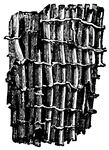
Magnified Portion of Tubipora Musica
"The Tubipora is a calcareous coral, formed by the combination of distinct, regularly arranged…

Tube and Polyp of Tubipora Musica
"The Tubipora is a calcareous coral, formed by the combination of distinct, regularly arranged…

Polyp of Tubipora Musica
"The Tubipora is a calcareous coral, formed by the combination of distinct, regularly arranged…
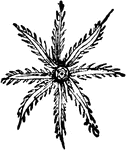
Crown of Delicately Fringed Tentacula of Tubipora Musica
"The Tubipora is a calcareous coral, formed by the combination of distinct, regularly arranged…
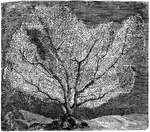
Gorgonia Flabellum
"The Fan Gorgon, from the Antilles; it often attains a height of eighteen or twenty inches. The…

Magnified Portion of Fan Gorgon
"The Fan Gorgon, from the Antilles; it often attains a height of eighteen or twenty inches. The…
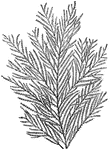
Gorgonia Verticellata
"The Fan Gorgon, from the Antilles; it often attains a height of eighteen or twenty inches. The…

Magnified Portion of Gorgonia Verticellata
"The Fan Gorgon, from the Antilles; it often attains a height of eighteen or twenty inches. The…

Isis Hippuris
"A species of Isis has numerous slender branches, furnished with cylindrical knows at intervals,…
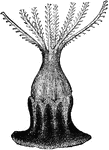
Coral Polyp (Lacaze-Duthiers)
"The polyp itself is formed of a whitish, membranous tube, nearly cylindrical, having an upper disk,…
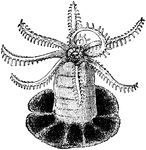
Coral Polyp (Lacaze-Duthiers)
"The arms of the polyps are at times subject to violent agitation, and the tentacula become much excited.…

Pennatula Spinosa
"These winged species of polypidom are somewhat scythe-shaped, well developed, and furnished with a…
Loose Winged Virgularia (Virgularia Mirabilis)
"These winged species of polypidom are somewhat scythe-shaped, well developed, and furnished with a…
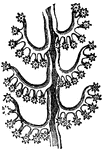
Branch of Loose Winged Virgularia
"These winged species of polypidom are somewhat scythe-shaped, well developed, and furnished with a…
Umbellularia Groenlandica (Lamarck)
"The Umbellularia Groenlandica has a very long stem, which is terminated at the summit only…

Veretillum Cynomorium (Lamarck)
"The species shown in this figure has a simple, cylindrical body, without branchiae, and a rudimentary…

Coralline
Coralline Rock is a type of rock formed by the death of layers of Coralline algae. It is visually quite…
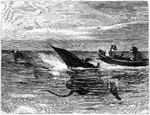
Manta Ray
The manta ray (Manta birostris), is the largest of the rays, with the largest known specimen having…

Cobra Head
Cobras are venomous snakes of the familys Elapidae, of several genera, but particularly Naja. (Non-cobra…

Precious Coral
An illustration of part of a stock of precious coral (red coral). Precious coral or red coral is the…

Moray Eel
Moray eels are large cosmopolitan eels of the family Muraenidae. There are approximately 200 species…

Seahorse
Seahorses are a genus (Hippocampus) of fish belonging to the family Syngnathidae, which also includes…
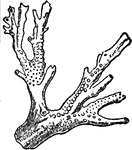
Coral
Corals are marine organisms from the class Anthozoa and exist as small sea anemone-like polyps, typically…
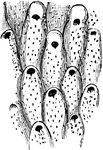
Prehistoric Bryozoan
Eschara elegans (Coscinopleura) is a prehistoric bryozoan, a marine animal similar to a coral.

Coral Head
Compound coral head with polyps partly expanded and partly contracted. The expanded polyps show the…
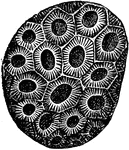
Coral Head
A compound coral head with crowded prismatic corallites. The specimen represents a worn pebble, formerly…
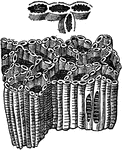
Chain Coral
The chain coral. This is an important index fossil of the Silurian, and an important limestone builder…
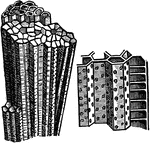
Compound Coral
A characteristic a-separate compound coral. The columns are prismatic and their walls pierced by regular…

Prehistoric Bryozoan
Eschara philomela is a prehistoric bryozoan, a marine animal similar to a coral.

Coral
Corals are marine organisms from the class Anthozoa and exist as small sea anemone–like polyps,…

